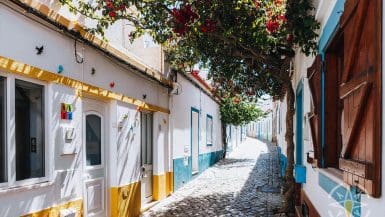Cape St. Vincent, named after the patron saint of Lisbon, known by its original name Cabo de São Vicente,is a place of exceptional geographical and historical significance. Situated at the southwestern tip of the European continent.It forms part of the Southwest Alentejo and Vicentine Coast Natural Park.

It is the final point from which Europe flickers its light – a beautiful lighthouse, recognized as one of the most powerful in the world, guiding ships safely along the route between the Atlantic Ocean and the Mediterranean Sea.
It stands as a symbol, connecting land with the majesty of the open ocean, once considered sacred in ancient times. Until the Age of Discovery, this was also considered the end of the known world for the people of Europe...
The history of the lighthouse at Cape St. Vincent
The lighthouse was originally established as a shelter for pilgrims, initiated by King Afonso III in 1260. Between 1279 and 1325, King Denis I transformed it into a monastery known as Convento do Corvo.
In 1516, the site was taken over by the Capuchin Order, and by 1520, a modest light was already shining from a special tower within the monastery. Though this small beacon was primitive, it served as illumination for the surrounding areas and the fortifications encircling it.

In 1587, the monastery and fortress fell victim to an attack by Francis Drake, resulting in significant damage. As a consequence, it remained inactive for two decades until the Capuchin brothers returned to the cape in 1606.
In 1846, Queen Maria II of Portugal ordered the installation of the first decent lighthouse on the Cape. Its light began to illuminate the area in October of the same year. Unfortunately, the site was abandoned soon afterwards for many years, until restoration work began in 1897. It was not until 1908 that the modernization work was completed, with the installation of the current optical equipment, which has greatly improved the quality of this extremely important navigational point on the European coast.
Another milestone in the lighthouse's development was its electrification in 1926 when incandescent light sources were introduced, thereby enhancing its effectiveness and reliability. A significant breakthrough occurred in 1982 when it was equipped with various automatons, significantly increasing its functionality and enabling more precise operations.

The most recent significant modernization occurred with the installation of a programmable optical rotation mechanism in 2001, further enhancing its efficiency and adapting it to modern technological standards.
Presently, the lighthouse at Cape St. Vincent boasts the largest optical system among all 47 Portuguese lighthouses and stands among the top ten worldwide. Sporting a Fresnel lens apparatus with a focal length of 1330 mm, equipped with three optical panels covering an area of 8 square meters and towering at a height of 3.58 meters, it plays a pivotal role in ensuring maritime safety, serving as a significant navigational landmark.
However, it's not just the maritime history that makes this place so fascinating. Cape St. Vincent is also a treasure trove of natural wonders—spectacular cliffs and an excellent spot to witness breathtaking sunsets. Additionally, it's a haven for migratory birds, especially birds of prey.
Currently, unfortunately, the building isn't open to visitors (2023)! I had the chance to explore the interior a few years back, and I regret not taking any photos. But as soon as it reopens, I'll definitely pay it another visit... 😉













Leave a comment, ask a question...